Borrelia burgdorferi NEU2011: Difference between revisions
ChojnowskaA (talk | contribs) |
ChojnowskaA (talk | contribs) |
||
| Line 25: | Line 25: | ||
== Description and Significance == | == Description and Significance == | ||
''Borellia burgdorferi'' is a spirochete which are cells that are both gram-negative and spiral-shaped with endoflagellum. The study of ''Borellia burgdorferi'' is very significant because it is the tick-borne agent of Lyme disease. Lyme disease is carried out by the bacterium, and transmitted through deer ticks which are known as ''Ixodes dammini'' (2). The disease was first discovered in 1982, by Willy Burgdorfer. He isolated spirochetes from the mid guts of ''Ixodes ticks'' and demonstrated that spirochetes and the immune serum reacted together from patients who were diagnosed with Lyme disease. Causes of the disease consist of inflammation all around the body, arthritis, heart problems and can also affect the nervous system (8). Researchers have been studying Lyme disease for a decade after they discovered the complete genome sequence for ''B. burgdorferi'' strain 31. Recently researchers determined the whole genome sequences of thirteen isolates of ''B. Burgdorferi''. The significance of this discovery proves that researchers will be able to improve the understanding of pathogenesis, and provide prevention strategies in the near future (7). [[File:Screen shot 2011-03-30 at 6.18.12 PM.png|250px|thumb|right|Total Genome Schematic of ''Borrelia burgdorferi'' (6)]] | |||
== Genome Structure == | == Genome Structure == | ||
Revision as of 04:31, 1 April 2011
Borrelia burgforferi NEU2011
A Microbial Biorealm page on the genus Borrelia burgdorferi NEU2011
Classification
Higher order taxa
Domain- Bacteria
Phylum- Spirochaetes
Class- Spirochaetes
Order- Spirochaetales
Family- Spirochaetaceae
Genus- Borrelia
Species- Borellia burgdorferi
Description and Significance
Borellia burgdorferi is a spirochete which are cells that are both gram-negative and spiral-shaped with endoflagellum. The study of Borellia burgdorferi is very significant because it is the tick-borne agent of Lyme disease. Lyme disease is carried out by the bacterium, and transmitted through deer ticks which are known as Ixodes dammini (2). The disease was first discovered in 1982, by Willy Burgdorfer. He isolated spirochetes from the mid guts of Ixodes ticks and demonstrated that spirochetes and the immune serum reacted together from patients who were diagnosed with Lyme disease. Causes of the disease consist of inflammation all around the body, arthritis, heart problems and can also affect the nervous system (8). Researchers have been studying Lyme disease for a decade after they discovered the complete genome sequence for B. burgdorferi strain 31. Recently researchers determined the whole genome sequences of thirteen isolates of B. Burgdorferi. The significance of this discovery proves that researchers will be able to improve the understanding of pathogenesis, and provide prevention strategies in the near future (7).
Genome Structure
The Borrelia burgdorferi genome contains 1.44 Mega base pairs with the number of G+C bases totaling 28%. It has a total of 22 DNA molecules including 21 extrachromosomal DNA elements, the largest known number of any bacterium (1). These include 12 linear and 9 circular plasmids which range from 5 to 56 kilobases (3). The plasmids contain a total of 1706 genes, including many pseudogenes, which suggests that the genome is actively evolving. It is also one of the few known bacteria to have a linear chromosome. Studies have shown that the linear plasmids have covalently closed ends, which occurs in some animal viruses but has not been found in prokaryotic organisms (5).
Cell Structure and Metabolism
The cell consists of a protoplasmic cylinder that includes the genome and cytoplasmic membrane, all enclosed by a flexible multilayered envelope. The cells have 5-7 coils and contain anywhere from 7-20 endoflagella, that are embedded in the periplasm and are located at each pole (4). The machinery used in motility is similar to other bacteria in that it has a filament, hook and basal body (6).
B. burgdorferi is classified as a microaerophilic chemoorganotroph; they derive energy from metabolizing organic molecules and require oxygen to survive, but in very low concentrations. They are known to have very limited metabolic capacity and are therefore difficult to culture in the lab (6).
Ecology
Borrelia burgdorferi is maintained in a natural cycle of infection by ticks. The ticks acquire and transmit the bacteria by feeding on a variety of small mammals and birds that act as a reservoir host for the Borrelia. B. burgdorferi is transmitted specifically by ticks of the genus Ixodes, which include a variety of different species found in different geographical locations. Ixodes scapularis is the most common vector and is found in the Northeastern US. Ixodes pacificus is found on the west coast, while species Ixodes ricinus and persulcatus are found in Europe and Asia. These ticks acquire and transmit the bacteria to different hosts during three distinct feeding phases of their life cycle; larval, nymphal and adult stages.
Pathology
Lyme disease was first identified due to an outbreak of juvenile rheumatoid arthritis. This is one of the later stage symptoms of the B. burgdorferi infection. Ticks use many small mammals to harbor the bacteria, and humans only become inadvertently infected when bitten. It is believed that the bacteria use a variety of mechanisms to evade the host immune response. This includes upregulating certain outer surface proteins, or attaching themselves to immunosuppressive tick salivary proteins. Once the Borrelia has entered the host, it becomes very invasive and can spread quickly throughout the entire system.
Current Research
Insert text here
Cool Factor
Insert text here
References
1. Casjens, S., Palmer, N., Van Vugt, R., Mun Huang, W., Stevenson, B., Rosa, P., Lathigra, R., Sutton, G., Peterson, J., Dodson, R. J., Haft, D., Hickey, E., Gwinn, M., White, O. and M. Fraser, C. (2000), A bacterial genome in flux: the twelve linear and nine circular extrachromosomal DNAs in an infectious isolate of the Lyme disease spirochete Borrelia burgdorferi. Molecular Microbiology, 35: 490–516. doi: 10.1046/j.1365-2958.2000.01698.x
2. Meyerhoff, John O. 2009. Lyme Disease Causes and Transmission. E-Medicine from WebMD, New York, NY: Healthwise Publishing.
3. Norris, Steven J. 2006. The dynamic proteome of Lyme disease Borrelia. Genome Biology, 7:209 doi:10.1186/gb-2006-7-3-209.
4. Madigan MT, Martinko JM, Dunlap PV, Clark DP. 2009. Brock Biology of Microorganisms. Twelfth Edition. San Francisco, CA: Pearson/Benjamin Cummings.
5. Barbour AG, Garon CF. July 1987. Linear plasmids of the bacterium Borrelia burgdorferi have covalently closed ends. Science Magazine, Vol. 237 no. 4813 pp. 409-411 DOI: 10.1126/science.3603026
6. Kahl O, Lane RS, Stanek G. 2002. Lyme Borreliosis : Biology, Epidemiology and Control. New York, NY: CABI Publishing.
7. Schutzer SE. 2011. Whole genome sequences of Borellia Burgdorferi. Journal of Bacteriology. 4:193 doi:10.1128/JB.01158-10.
8. Sternbach G, Dibble CL. 1996. Willy Burgdorfer: Lyme Disease. Journal of Emergency Medicine. 4:631



